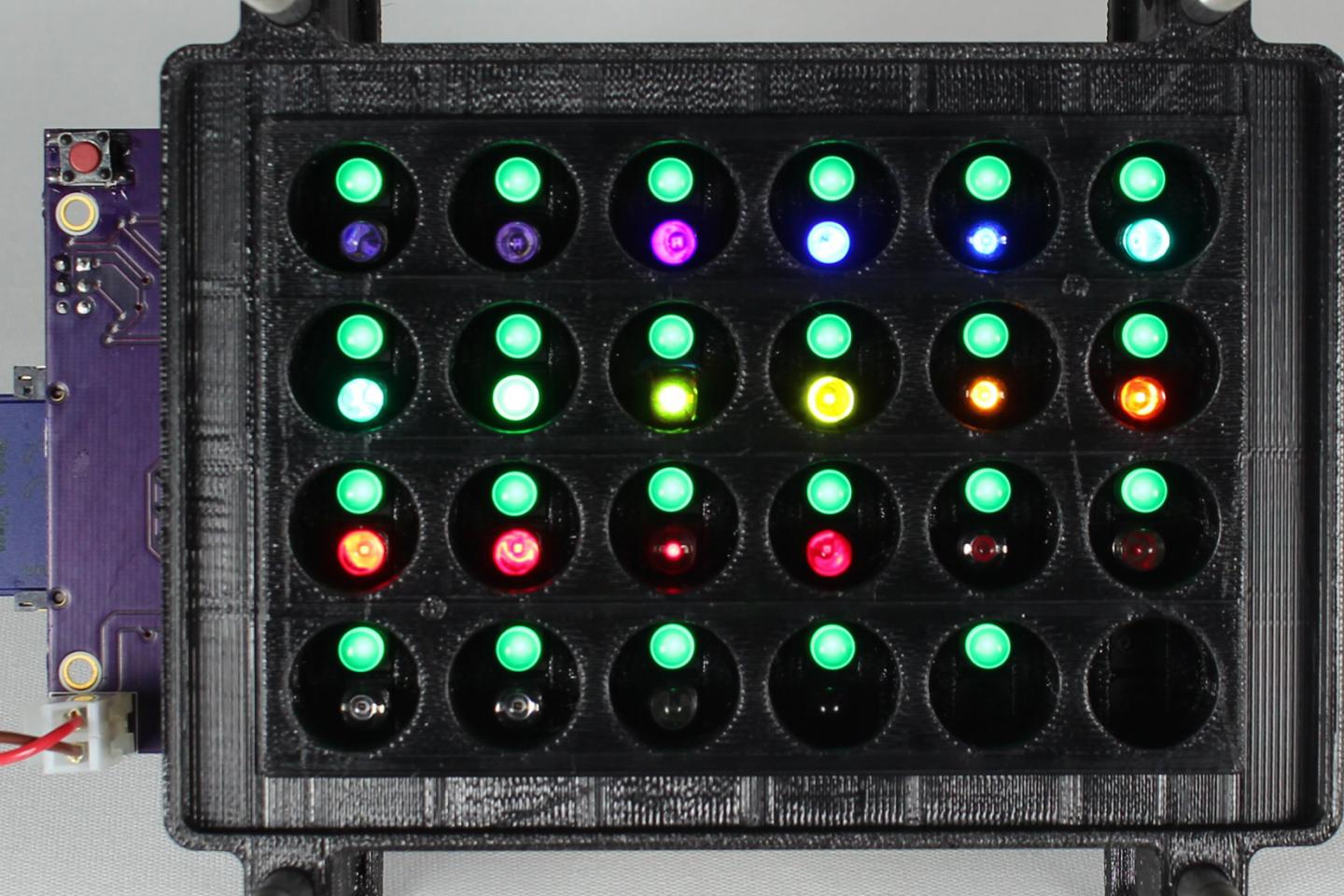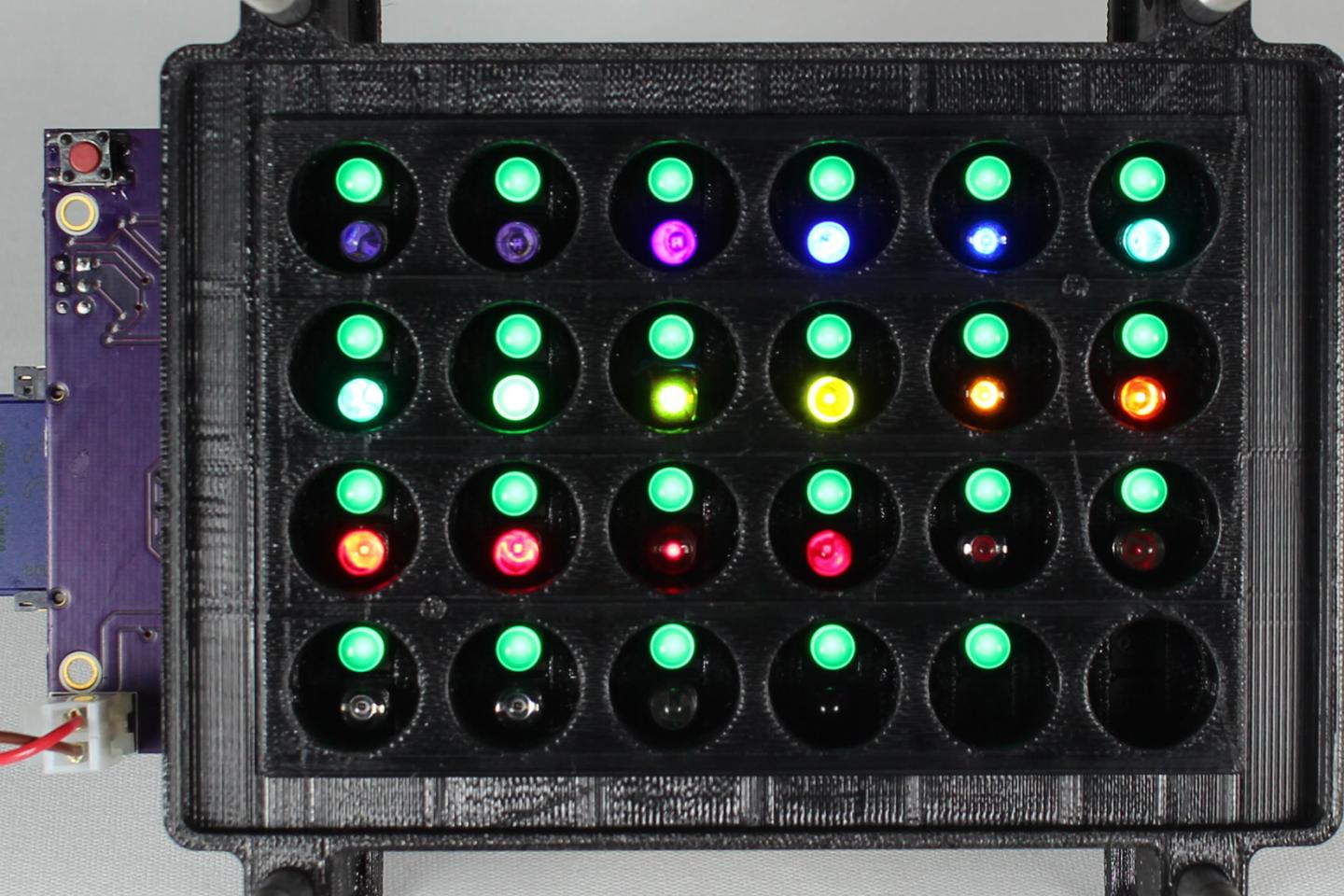
Credit: Karl Gerhardt/Rice University
Rice University bioengineers who specialize in creating tools for synthetic biology have unveiled the latest version of their "biofunction generator and "bioscilloscope," an optogenetic platform that uses light to activate and study two biological circuits at a time.
The biofunction generator and bioscilloscope are a toolkit of genes and hardware that use colored lights and engineered bacteria to bring both mathematical predictability and cut-and-paste simplicity to the world of genetic circuit design.
"Unfortunately, all biological light sensors are 'sloppy,' in that they tend to respond to multiple colors of light," said Jeffrey Tabor, an associate professor of bioengineering at Rice. "We've developed a detailed mathematical model to capture this sloppiness and design multicolor light signals that compensate for it so that two light sensors can be independently controlled in the same cell. Because most of the circuits that control biological behaviors are composed of two or more genes, this technology will make it easier for our lab and others to study complex synthetic biological systems."
The research is described in a recent paper in Molecular Systems Biology.
Life is controlled by DNA-based circuits. These are similar to the circuits in smartphones and other electronic devices with a key difference: The information that flows through electronic circuitry is voltage, and the information that flows through genetic circuits is protein production. Genetic circuits can be switched on or off — produce protein or not — and they can be tuned to produce more or less protein, much like voltage from an electronic circuit can be raised or lowered.
The biofunction generator and bioscilloscope, which were first created in Tabor's lab three years ago, show how closely the analogy holds. Function generators and oscilloscopes, stock components of electrical engineering labs for more than 50 years, are test instruments that can feed voltage signals into circuits and show how signal voltage varies with time at other locations within the circuit. Oscilloscope screens usually show wave functions and can plot one or more signals at a time.
The bioscilloscope plots the output of biocircuits in exactly the same way. The inputs and outputs for the biocircuits are light. Specifically, Tabor's team has developed a biofunction generator, a set of light-activated genes that can be used to turn genes on and off and to regulate the amount of protein they produce when turned on. The bioscilloscope comprises another set of genes that add fluorescent tags to the DNA to read out the circuit response, which means the more protein that's produced, the more light that's given off by the sample.
In the new paper, recent Ph.D. graduate and lead author Evan Olson and colleagues tested new dual-function tools using the latest optogenetic hardware and software tools developed by Tabor's lab in conjunction with a new mathematical model for the biofunction generator output.
"The model allows us to predict the output gene-expression response to any light input signal, regardless of how the intensity or spectral composition of the light signal changes over time," Olson said. "The model works by describing how light of any wavelength and intensity is converted into a population of light sensors in the 'on' or 'off' states."
Olson said they demonstrated the system in two proof-of-concept experiments. In the first, they showed the system could compensate for "perturbative" signals, incoming light such as that from a microscope or fluorescent imager that might otherwise interfere with the incoming optogenetic signal. In the second, they demonstrated multiplexed control by simultaneously driving two independent gene expression signals in two optogenetic circuits in the same bacteria. The output on the bioscilloscope shows the two functions as red and green lines. The researchers showed they could activate the genetic circuits to produce smooth waves and stair-step patterns, and they showed the two circuits could be switched on in unison or at different times.
"This multiplexing approach enables a completely new generation of experiments for characterizing and controlling the biological circuits that integrate multiple signals and that are ubiquitous in biological networks, particularly those used for decision-making and developmental processes," Tabor said.
###
The study was co-authored by undergraduate Constantine Tzouanas. The research was supported by the Office of Naval Research and the National Science Foundation.
The DOI of the Molecular Systems Biology paper is: 10.15252/msb.20167456
A copy of the paper is available at: http://msb.embopress.org/content/13/4/926
Related research from Rice:
Synthetic biologists engineer inflammation-sensing gut bacteria — April 5, 2017
http://news.rice.edu/2017/04/05/synthetic-biologists-engineer-inflammation-sensing-gut-bacteria/
Rice U. lab creates open-source optogenetics hardware, software — Nov. 7, 2016
http://news.rice.edu/2016/11/07/rice-u-lab-creates-open-source-optogenetics-hardware-software/
Photosynthetic bacteria give biologists a cool new tool — May 10, 2016
http://news.rice.edu/2016/05/10/photosynthetic-bacteria-give-biologists-a-cool-new-tool/
It's now easier to go with the flow — May 3, 2016
http://news.rice.edu/2016/05/03/its-now-easier-to-go-with-the-flow/
Jeffrey Tabor wins CAREER Award — April 4, 2016
http://news.rice.edu/2016/04/04/jeffrey-tabor-wins-career-award-2/
Red means 'go' to therapeutic viruses — Dec. 1, 2015
http://news.rice.edu/2015/12/01/red-means-go-to-therapeutic-viruses/
No bioengineered gut bacteria, no glory — May 12, 2014
http://news.rice.edu/2014/05/12/no-bioengineered-gut-bacteria-no-glory/
Rice synthetic biologists shine light on genetic circuit analysis — March 9, 2014
http://news.rice.edu/2014/03/09/rice-synthetic-biologists-shine-light-on-genetic-circuit-analysis/
Rice, UW win $2M grant for synthetic biology research — Sept. 12, 2011
http://news.rice.edu/2011/09/12/rice-uw-win-2m-grant-for-synthetic-biology-research/
This release can be found online at news.rice.edu.
Follow Rice News and Media Relations via Twitter @RiceUNews
Located on a 300-acre forested campus in Houston, Rice University is consistently ranked among the nation's top 20 universities by U.S. News & World Report. Rice has highly respected schools of Architecture, Business, Continuing Studies, Engineering, Humanities, Music, Natural Sciences and Social Sciences and is home to the Baker Institute for Public Policy. With 3,879 undergraduates and 2,861 graduate students, Rice's undergraduate student-to-faculty ratio is 6-to-1. Its residential college system builds close-knit communities and lifelong friendships, just one reason why Rice is ranked No. 1 for happiest students and for lots of race/class interaction by the Princeton Review. Rice is also rated as a best value among private universities by Kiplinger's Personal Finance. To read "What they're saying about Rice," go to http://tinyurl.com/RiceUniversityoverview.
Media Contact
David Ruth
[email protected]
713-348-6327
@RiceUNews
http://news.rice.edu
Related Journal Article
http://dx.doi.org/10.15252/msb.20167456





